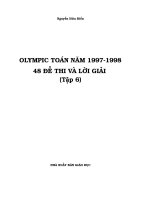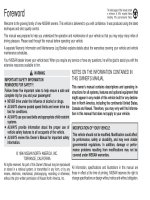D5268 92(reapproved 1997)
Bạn đang xem bản rút gọn của tài liệu. Xem và tải ngay bản đầy đủ của tài liệu tại đây (21.11 KB, 2 trang )
Designation: D 5268 – 92 (Reapproved 1997)
AMERICAN SOCIETY FOR TESTING AND MATERIALS
100 Barr Harbor Dr., West Conshohocken, PA 19428
Reprinted from the Annual Book of ASTM Standards. Copyright ASTM
Standard Specification for
Topsoil Used for Landscaping Purposes1
This standard is issued under the fixed designation D 5268; the number immediately following the designation indicates the year of
original adoption or, in the case of revision, the year of last revision. A number in parentheses indicates the year of last reapproval. A
superscript epsilon (e) indicates an editorial change since the last revision or reapproval.
1. Scope
1.1 This specification covers a physical evaluation of an
inorganic soil containing a limited amount of organic material,
relative to its use as a topsoil for horticultural purposes in
construction. For classification, a full agricultural textural
classification may be used.
1.2 The presence in the soil of the correct nutrients and pH
status is necessary for healthy plant growth. This specification
does not, however, cover a determination of the nutrients, nor
their availability.2
E 11 Specification for Wire-Cloth Sieves for Testing Purposes4
3. Terminology
3.1 Definitions:
3.1.1 For definitions of other terms used in this specification, refer to Terminology D 653.
3.2 Description of Term Specific to This Standard:
3.2.1 topsoil—usually the original surface layer of grassland or cultivated land. It does not generally include soil from
peatlands or other special areas, such as land disturbed by
industrial activity. Topsoil is usually a darker shade of brown,
grey, or red than the subsoil that lies immediately beneath it,
because it contains organic matter intimately mixed with the
mineral matter. Topsoil tends to be more friable and pervious
than inorganic soils.
NOTE 1—The nutrient content of topsoil is important and the chemicals
usually evaluated are nitrogen, phosphate, and potassium. Nutrient deficiencies may be corrected using fertilizers. Excess soluble salts should be
examined as to their desirability. The acidity or alkalinity of the soil is also
important. Excess acidity may be corrected by the application of lime dust.
Excess alkalinity may be corrected by the application of sulfur or other
suitable acidifying compounds. The latter item, in addition to lowering
pH, also could be considered as an aggregate when considering the
particle size distribution.
4. Significance and Use
4.1 When physically evaluating a soil, relative to its suitability to support plant growth (primarily grasses), tests must
be made to determine the presence and the amount of organic
matter, inorganic matter (sand, silt and clay), and deleterious
materials.
4.2 Typical general ranges of soil content are presented in
Table 1. Soils falling within these ranges will generally form a
suitable topsoil. It must, however, be recognized that in some
geographic regions, concurrence with the values of Table 1
would be most difficult. In such cases, locally acceptable
specifications would need to be developed.
1.3 The values stated in SI units are to be regarded as the
standard.
1.4 This standard does not purport to address all of the
safety concerns, if any, associated with its use. It is the
responsibility of the user of this standard to establish appropriate safety and health practices and determine the applicability of regulatory limitations prior to use.
2. Referenced Documents
2.1 ASTM Standards:
D 653 Terminology Relating to Soil, Rock, and Contained
Fluids3
D 1140 Test Method for Amount of Material in Soils Finer
than No. 200 (75 µm) Sieve3
D 2974 Test Methods for Moisture, Ash, and Organic Matter of Peat and Other Organic Materials3
D 4972 Test Method for pH of Soils3
5. Apparatus
5.1 Sieves and Containers, in accordance with Test Method
D 1140.
5.2 Muffle Furnace, capable of producing the required
ashing temperature in accordance with Test Methods D 2974.
6. Procedure
6.1 Select a representative sample of the topsoil as indicated
in Test Method D 1140.
6.2 Oven-dry the sample at 105 6 5°C and determine its
mass.
6.3 Screen the sample over a No. 4 (4.75 mm) sieve and
identify this deleterious material fraction as rock, gravel, slag,
cinder, roots, sod, and the like.
1
This specification is under the jurisdiction of ASTM Committee D-18 on Soil
and Rock and is the direct responsibility of Subcommittee D18.18 on Peats and
Related Materials.
Current edition approved July 15, 1992. Published September 1992.
2
Nutrient testing procedures are found in: the state Agricultural Experiment
Station recommendations from the state within which the landscape is located,“
Methods of Soil Analysis” Editor-in-Chief: C. A. Black, Agronomy No. 9, Vol 2,
American Society of Agronomy, Inc., Madison, WI, and Hesse, P. R., A Textbook of
Soil Chemical Analysis, Chemical Publishing Co., New York, NY, 1972.
3
Annual Book of ASTM Standards, Vol 04.08.
4
1
Annual Book of ASTM Standards, Vol 14.02.
D 5268
TABLE 1 Specification for Topsoil
Compositional Category
Total Sample:
Deleterious materials
(rock, gravel, slag, cinder,
roots, sod)
Material passing the No. 4 (4.75 mm) sieve:
Organic material
Sand content
Silt and clay content
pH
mm) sieve fraction that is retained on the No. 200 (75 µm)
sieve. Take care to agitate the samples so that all organic matter
be decanted away. This represents the sand content. Calculate
the silt/clay content of the minus No. 4 (4.75 mm) sieve
material as the difference between 100 and the sum of the sand
and organic matter percentages.
Percentage by Mass
5 max
2 to 20
20 to 60
35 to 70
7. Report
7.1 Report the percentages by mass of the following:
7.1.1 Deleterious materials.
7.1.2 Organic material.
7.1.3 Sand content, and
7.1.4 Silt and clay content.
5 to 7
6.4 Take a specimen of the fraction passing the No. 4 (4.75
mm) sieve and determine the percentage by mass of organic
matter fractions by ashing at 440°C using the techniques
described in Test Methods D 2974.
6.5 Take another specimen and test in accordance with Test
Method D 1140 to find the percentage of the minus No. 4 (4.75
8. Keywords
8.1 landscaping; organic material; plant growth; soil; topsoil
The American Society for Testing and Materials takes no position respecting the validity of any patent rights asserted in connection
with any item mentioned in this standard. Users of this standard are expressly advised that determination of the validity of any such
patent rights, and the risk of infringement of such rights, are entirely their own responsibility.
This standard is subject to revision at any time by the responsible technical committee and must be reviewed every five years and
if not revised, either reapproved or withdrawn. Your comments are invited either for revision of this standard or for additional standards
and should be addressed to ASTM Headquarters. Your comments will receive careful consideration at a meeting of the responsible
technical committee, which you may attend. If you feel that your comments have not received a fair hearing you should make your
views known to the ASTM Committee on Standards, 100 Barr Harbor Drive, West Conshohocken, PA 19428.
2









